Finance Report: AASB Conceptual Framework Analysis and Discussion
VerifiedAdded on 2022/08/29
|12
|2543
|19
Report
AI Summary
This report provides a comprehensive analysis of the AASB Conceptual Framework, addressing key concepts such as faithful representation, neutrality, and historical cost accounting. It examines the political dimensions of financial reporting, the role of prudence, and the impact of the IASB's decisions on the framework. The report discusses the merits and limitations of historical cost accounting compared to alternative methods like current purchasing power and current cost accounting. It also explores the framework's influence on standard setting, international compatibility, and the challenges faced in its development, including political interference and the consideration of economic performance. The report concludes by highlighting areas of the framework that require revision and emphasizes the importance of historical cost accounting in providing an objective view of financial performance.
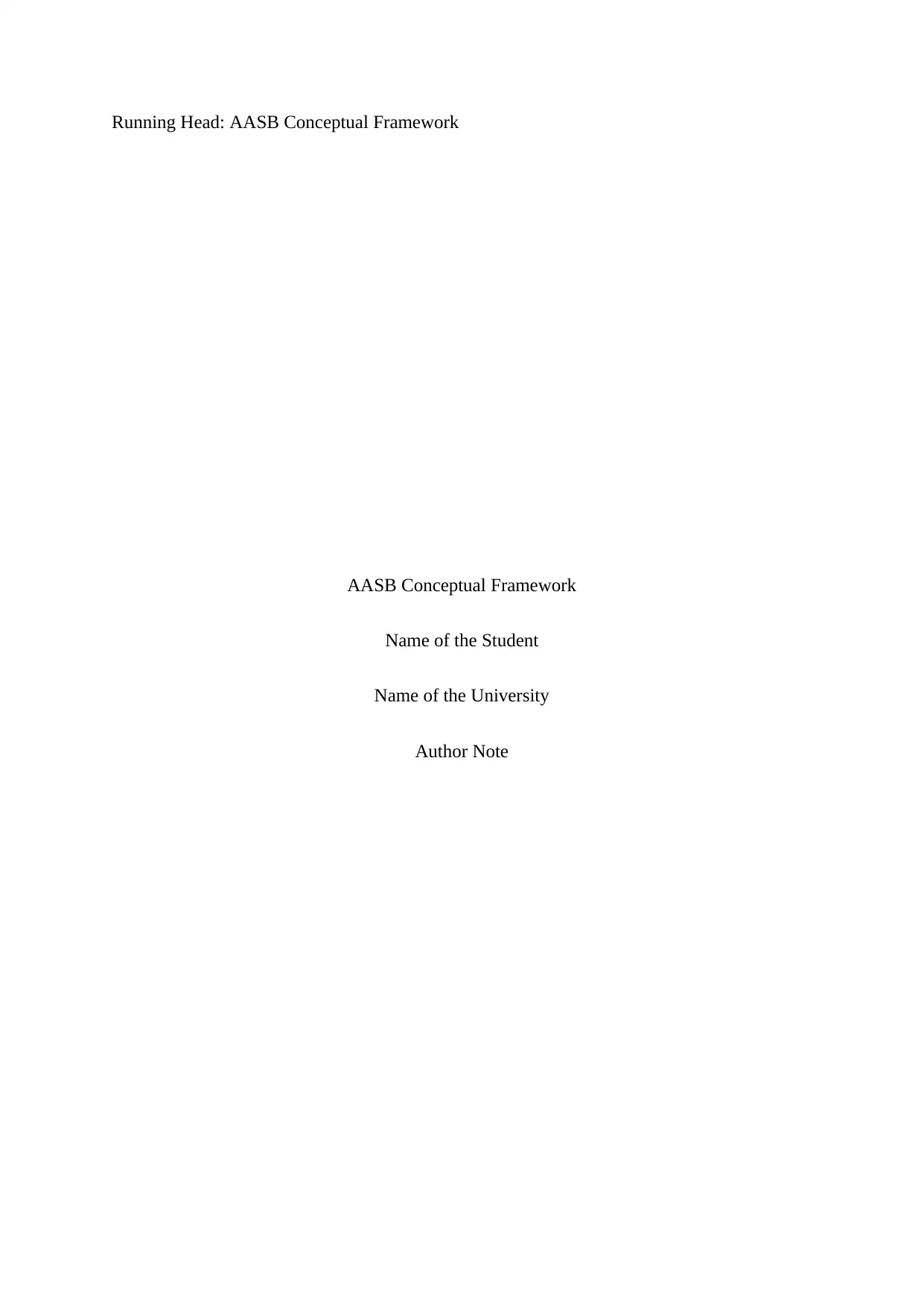
Running Head: AASB Conceptual Framework
AASB Conceptual Framework
Name of the Student
Name of the University
Author Note
AASB Conceptual Framework
Name of the Student
Name of the University
Author Note
Paraphrase This Document
Need a fresh take? Get an instant paraphrase of this document with our AI Paraphraser
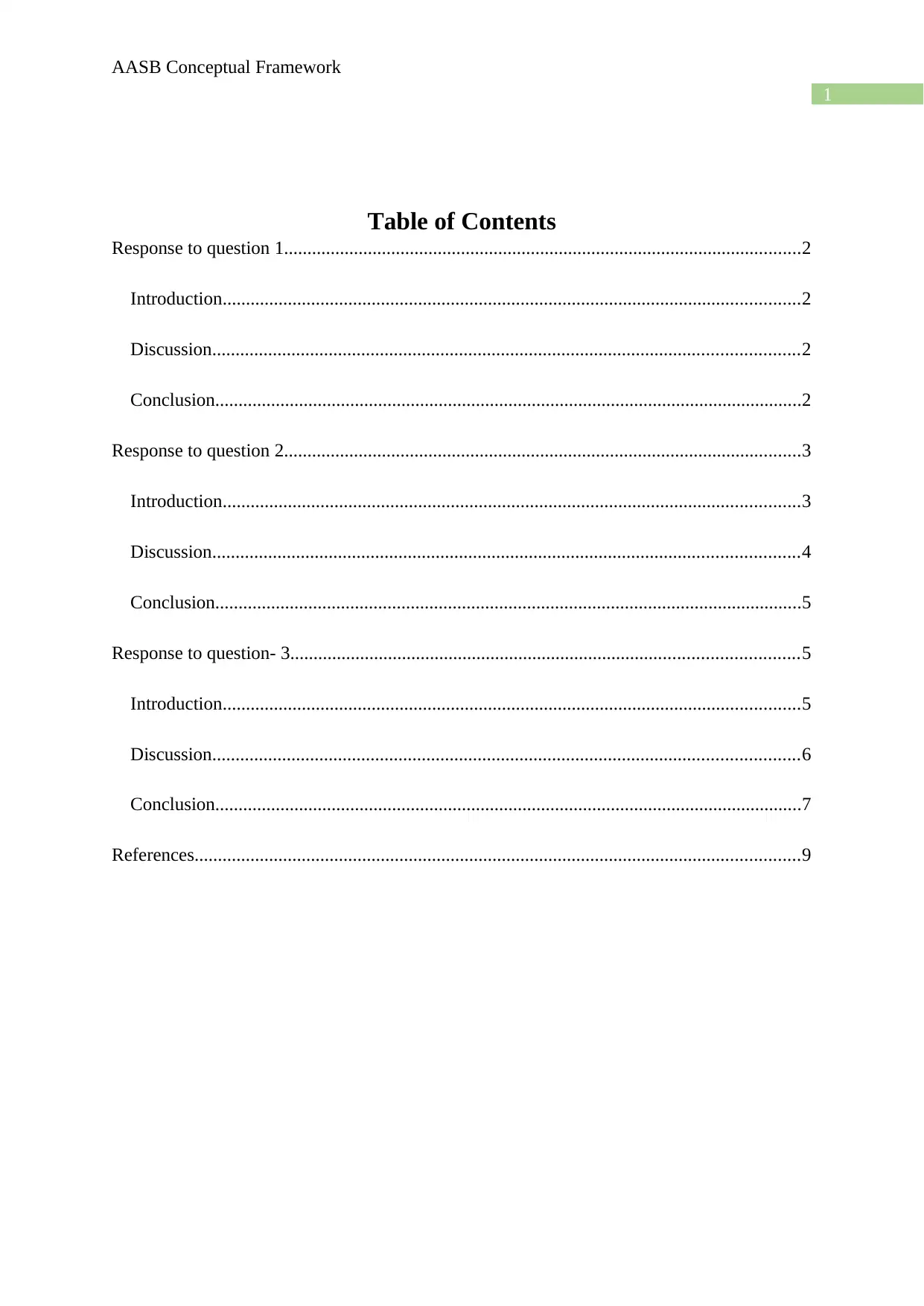
1
AASB Conceptual Framework
Table of Contents
Response to question 1...............................................................................................................2
Introduction............................................................................................................................2
Discussion..............................................................................................................................2
Conclusion..............................................................................................................................2
Response to question 2...............................................................................................................3
Introduction............................................................................................................................3
Discussion..............................................................................................................................4
Conclusion..............................................................................................................................5
Response to question- 3.............................................................................................................5
Introduction............................................................................................................................5
Discussion..............................................................................................................................6
Conclusion..............................................................................................................................7
References..................................................................................................................................9
AASB Conceptual Framework
Table of Contents
Response to question 1...............................................................................................................2
Introduction............................................................................................................................2
Discussion..............................................................................................................................2
Conclusion..............................................................................................................................2
Response to question 2...............................................................................................................3
Introduction............................................................................................................................3
Discussion..............................................................................................................................4
Conclusion..............................................................................................................................5
Response to question- 3.............................................................................................................5
Introduction............................................................................................................................5
Discussion..............................................................................................................................6
Conclusion..............................................................................................................................7
References..................................................................................................................................9
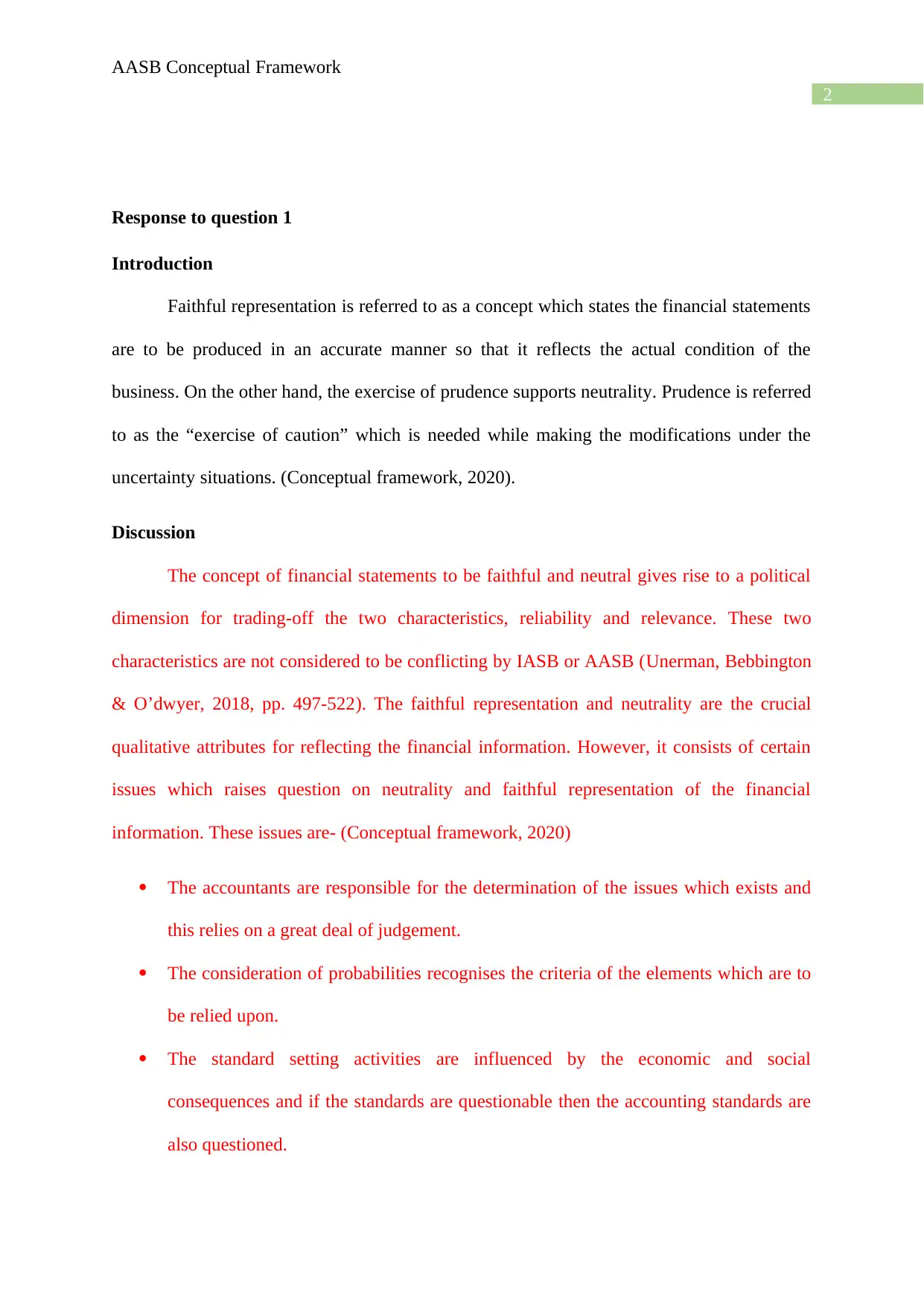
2
AASB Conceptual Framework
Response to question 1
Introduction
Faithful representation is referred to as a concept which states the financial statements
are to be produced in an accurate manner so that it reflects the actual condition of the
business. On the other hand, the exercise of prudence supports neutrality. Prudence is referred
to as the “exercise of caution” which is needed while making the modifications under the
uncertainty situations. (Conceptual framework, 2020).
Discussion
The concept of financial statements to be faithful and neutral gives rise to a political
dimension for trading-off the two characteristics, reliability and relevance. These two
characteristics are not considered to be conflicting by IASB or AASB (Unerman, Bebbington
& O’dwyer, 2018, pp. 497-522). The faithful representation and neutrality are the crucial
qualitative attributes for reflecting the financial information. However, it consists of certain
issues which raises question on neutrality and faithful representation of the financial
information. These issues are- (Conceptual framework, 2020)
The accountants are responsible for the determination of the issues which exists and
this relies on a great deal of judgement.
The consideration of probabilities recognises the criteria of the elements which are to
be relied upon.
The standard setting activities are influenced by the economic and social
consequences and if the standards are questionable then the accounting standards are
also questioned.
AASB Conceptual Framework
Response to question 1
Introduction
Faithful representation is referred to as a concept which states the financial statements
are to be produced in an accurate manner so that it reflects the actual condition of the
business. On the other hand, the exercise of prudence supports neutrality. Prudence is referred
to as the “exercise of caution” which is needed while making the modifications under the
uncertainty situations. (Conceptual framework, 2020).
Discussion
The concept of financial statements to be faithful and neutral gives rise to a political
dimension for trading-off the two characteristics, reliability and relevance. These two
characteristics are not considered to be conflicting by IASB or AASB (Unerman, Bebbington
& O’dwyer, 2018, pp. 497-522). The faithful representation and neutrality are the crucial
qualitative attributes for reflecting the financial information. However, it consists of certain
issues which raises question on neutrality and faithful representation of the financial
information. These issues are- (Conceptual framework, 2020)
The accountants are responsible for the determination of the issues which exists and
this relies on a great deal of judgement.
The consideration of probabilities recognises the criteria of the elements which are to
be relied upon.
The standard setting activities are influenced by the economic and social
consequences and if the standards are questionable then the accounting standards are
also questioned.
⊘ This is a preview!⊘
Do you want full access?
Subscribe today to unlock all pages.

Trusted by 1+ million students worldwide
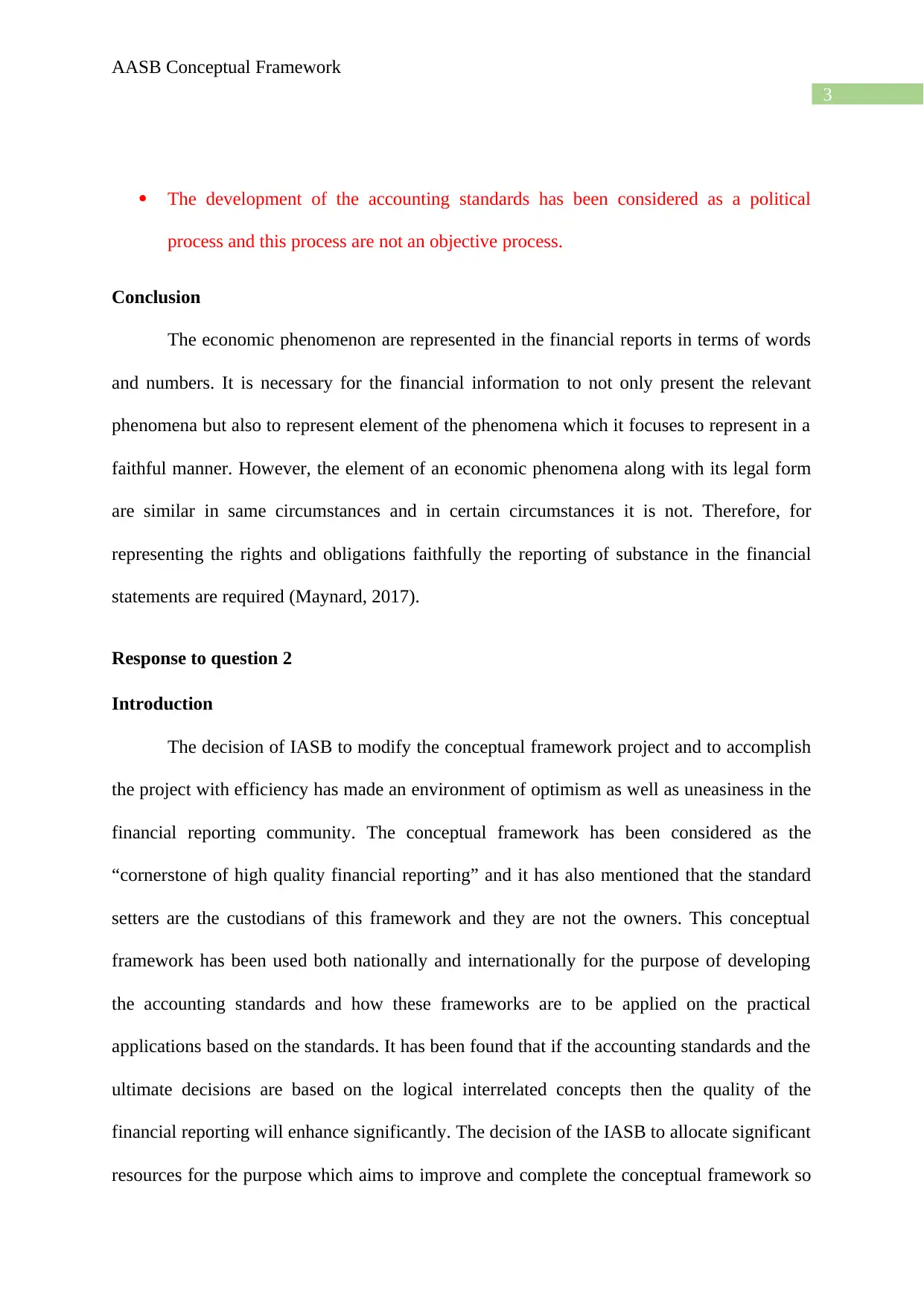
3
AASB Conceptual Framework
The development of the accounting standards has been considered as a political
process and this process are not an objective process.
Conclusion
The economic phenomenon are represented in the financial reports in terms of words
and numbers. It is necessary for the financial information to not only present the relevant
phenomena but also to represent element of the phenomena which it focuses to represent in a
faithful manner. However, the element of an economic phenomena along with its legal form
are similar in same circumstances and in certain circumstances it is not. Therefore, for
representing the rights and obligations faithfully the reporting of substance in the financial
statements are required (Maynard, 2017).
Response to question 2
Introduction
The decision of IASB to modify the conceptual framework project and to accomplish
the project with efficiency has made an environment of optimism as well as uneasiness in the
financial reporting community. The conceptual framework has been considered as the
“cornerstone of high quality financial reporting” and it has also mentioned that the standard
setters are the custodians of this framework and they are not the owners. This conceptual
framework has been used both nationally and internationally for the purpose of developing
the accounting standards and how these frameworks are to be applied on the practical
applications based on the standards. It has been found that if the accounting standards and the
ultimate decisions are based on the logical interrelated concepts then the quality of the
financial reporting will enhance significantly. The decision of the IASB to allocate significant
resources for the purpose which aims to improve and complete the conceptual framework so
AASB Conceptual Framework
The development of the accounting standards has been considered as a political
process and this process are not an objective process.
Conclusion
The economic phenomenon are represented in the financial reports in terms of words
and numbers. It is necessary for the financial information to not only present the relevant
phenomena but also to represent element of the phenomena which it focuses to represent in a
faithful manner. However, the element of an economic phenomena along with its legal form
are similar in same circumstances and in certain circumstances it is not. Therefore, for
representing the rights and obligations faithfully the reporting of substance in the financial
statements are required (Maynard, 2017).
Response to question 2
Introduction
The decision of IASB to modify the conceptual framework project and to accomplish
the project with efficiency has made an environment of optimism as well as uneasiness in the
financial reporting community. The conceptual framework has been considered as the
“cornerstone of high quality financial reporting” and it has also mentioned that the standard
setters are the custodians of this framework and they are not the owners. This conceptual
framework has been used both nationally and internationally for the purpose of developing
the accounting standards and how these frameworks are to be applied on the practical
applications based on the standards. It has been found that if the accounting standards and the
ultimate decisions are based on the logical interrelated concepts then the quality of the
financial reporting will enhance significantly. The decision of the IASB to allocate significant
resources for the purpose which aims to improve and complete the conceptual framework so
Paraphrase This Document
Need a fresh take? Get an instant paraphrase of this document with our AI Paraphraser
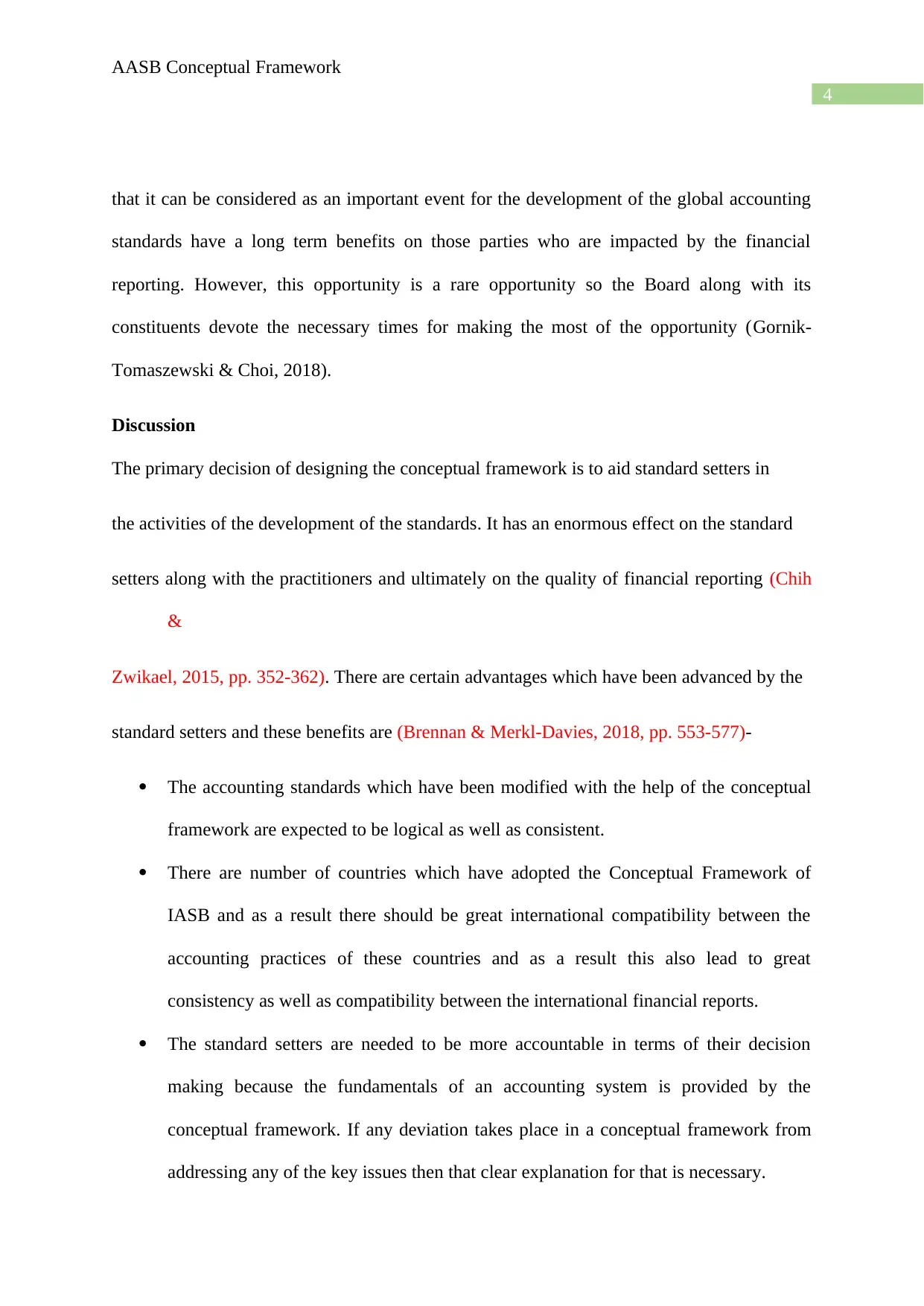
4
AASB Conceptual Framework
that it can be considered as an important event for the development of the global accounting
standards have a long term benefits on those parties who are impacted by the financial
reporting. However, this opportunity is a rare opportunity so the Board along with its
constituents devote the necessary times for making the most of the opportunity (Gornik-
Tomaszewski & Choi, 2018).
Discussion
The primary decision of designing the conceptual framework is to aid standard setters in
the activities of the development of the standards. It has an enormous effect on the standard
setters along with the practitioners and ultimately on the quality of financial reporting (Chih
&
Zwikael, 2015, pp. 352-362). There are certain advantages which have been advanced by the
standard setters and these benefits are (Brennan & Merkl-Davies, 2018, pp. 553-577)-
The accounting standards which have been modified with the help of the conceptual
framework are expected to be logical as well as consistent.
There are number of countries which have adopted the Conceptual Framework of
IASB and as a result there should be great international compatibility between the
accounting practices of these countries and as a result this also lead to great
consistency as well as compatibility between the international financial reports.
The standard setters are needed to be more accountable in terms of their decision
making because the fundamentals of an accounting system is provided by the
conceptual framework. If any deviation takes place in a conceptual framework from
addressing any of the key issues then that clear explanation for that is necessary.
AASB Conceptual Framework
that it can be considered as an important event for the development of the global accounting
standards have a long term benefits on those parties who are impacted by the financial
reporting. However, this opportunity is a rare opportunity so the Board along with its
constituents devote the necessary times for making the most of the opportunity (Gornik-
Tomaszewski & Choi, 2018).
Discussion
The primary decision of designing the conceptual framework is to aid standard setters in
the activities of the development of the standards. It has an enormous effect on the standard
setters along with the practitioners and ultimately on the quality of financial reporting (Chih
&
Zwikael, 2015, pp. 352-362). There are certain advantages which have been advanced by the
standard setters and these benefits are (Brennan & Merkl-Davies, 2018, pp. 553-577)-
The accounting standards which have been modified with the help of the conceptual
framework are expected to be logical as well as consistent.
There are number of countries which have adopted the Conceptual Framework of
IASB and as a result there should be great international compatibility between the
accounting practices of these countries and as a result this also lead to great
consistency as well as compatibility between the international financial reports.
The standard setters are needed to be more accountable in terms of their decision
making because the fundamentals of an accounting system is provided by the
conceptual framework. If any deviation takes place in a conceptual framework from
addressing any of the key issues then that clear explanation for that is necessary.
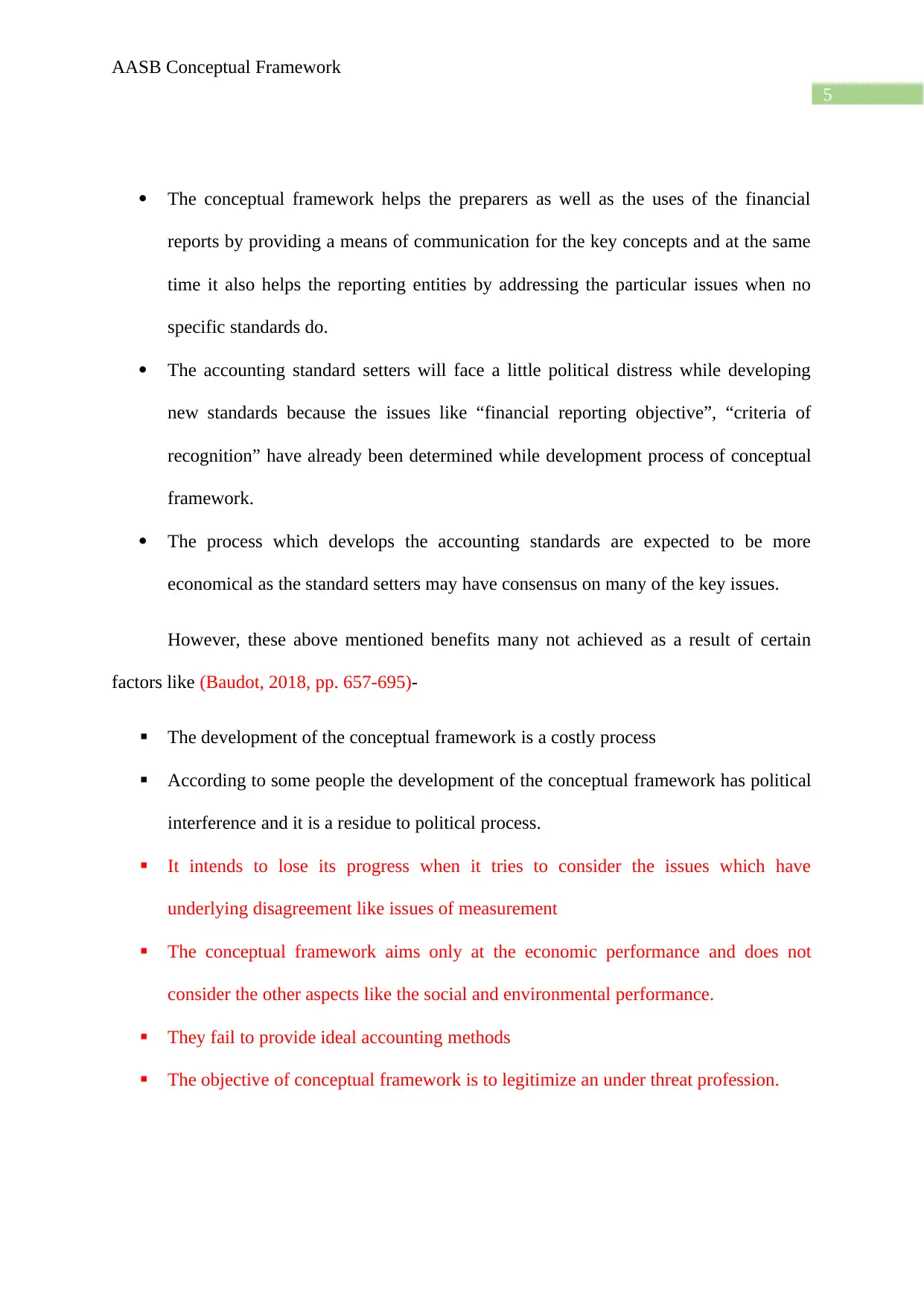
5
AASB Conceptual Framework
The conceptual framework helps the preparers as well as the uses of the financial
reports by providing a means of communication for the key concepts and at the same
time it also helps the reporting entities by addressing the particular issues when no
specific standards do.
The accounting standard setters will face a little political distress while developing
new standards because the issues like “financial reporting objective”, “criteria of
recognition” have already been determined while development process of conceptual
framework.
The process which develops the accounting standards are expected to be more
economical as the standard setters may have consensus on many of the key issues.
However, these above mentioned benefits many not achieved as a result of certain
factors like (Baudot, 2018, pp. 657-695)-
The development of the conceptual framework is a costly process
According to some people the development of the conceptual framework has political
interference and it is a residue to political process.
It intends to lose its progress when it tries to consider the issues which have
underlying disagreement like issues of measurement
The conceptual framework aims only at the economic performance and does not
consider the other aspects like the social and environmental performance.
They fail to provide ideal accounting methods
The objective of conceptual framework is to legitimize an under threat profession.
AASB Conceptual Framework
The conceptual framework helps the preparers as well as the uses of the financial
reports by providing a means of communication for the key concepts and at the same
time it also helps the reporting entities by addressing the particular issues when no
specific standards do.
The accounting standard setters will face a little political distress while developing
new standards because the issues like “financial reporting objective”, “criteria of
recognition” have already been determined while development process of conceptual
framework.
The process which develops the accounting standards are expected to be more
economical as the standard setters may have consensus on many of the key issues.
However, these above mentioned benefits many not achieved as a result of certain
factors like (Baudot, 2018, pp. 657-695)-
The development of the conceptual framework is a costly process
According to some people the development of the conceptual framework has political
interference and it is a residue to political process.
It intends to lose its progress when it tries to consider the issues which have
underlying disagreement like issues of measurement
The conceptual framework aims only at the economic performance and does not
consider the other aspects like the social and environmental performance.
They fail to provide ideal accounting methods
The objective of conceptual framework is to legitimize an under threat profession.
⊘ This is a preview!⊘
Do you want full access?
Subscribe today to unlock all pages.

Trusted by 1+ million students worldwide
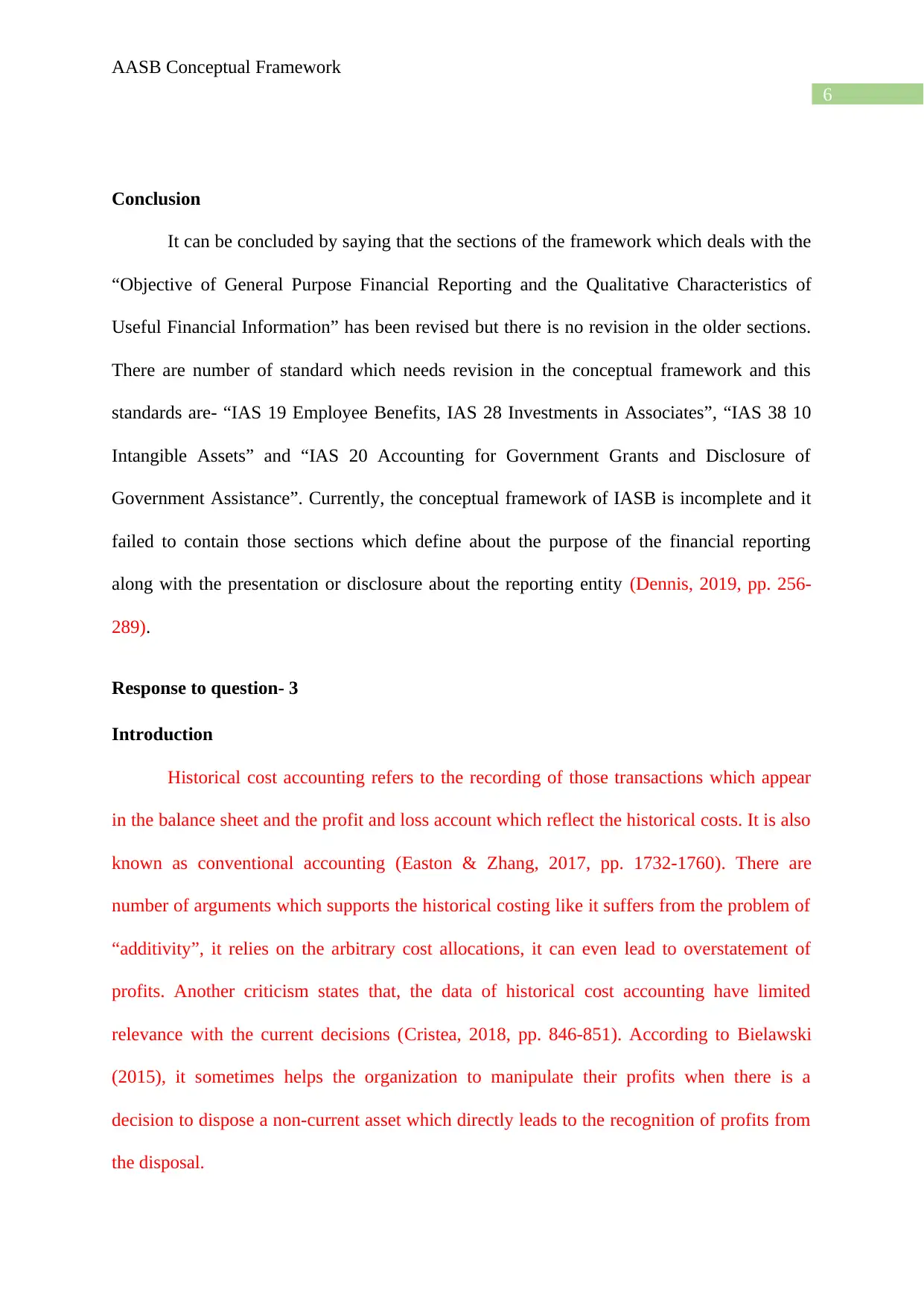
6
AASB Conceptual Framework
Conclusion
It can be concluded by saying that the sections of the framework which deals with the
“Objective of General Purpose Financial Reporting and the Qualitative Characteristics of
Useful Financial Information” has been revised but there is no revision in the older sections.
There are number of standard which needs revision in the conceptual framework and this
standards are- “IAS 19 Employee Benefits, IAS 28 Investments in Associates”, “IAS 38 10
Intangible Assets” and “IAS 20 Accounting for Government Grants and Disclosure of
Government Assistance”. Currently, the conceptual framework of IASB is incomplete and it
failed to contain those sections which define about the purpose of the financial reporting
along with the presentation or disclosure about the reporting entity (Dennis, 2019, pp. 256-
289).
Response to question- 3
Introduction
Historical cost accounting refers to the recording of those transactions which appear
in the balance sheet and the profit and loss account which reflect the historical costs. It is also
known as conventional accounting (Easton & Zhang, 2017, pp. 1732-1760). There are
number of arguments which supports the historical costing like it suffers from the problem of
“additivity”, it relies on the arbitrary cost allocations, it can even lead to overstatement of
profits. Another criticism states that, the data of historical cost accounting have limited
relevance with the current decisions (Cristea, 2018, pp. 846-851). According to Bielawski
(2015), it sometimes helps the organization to manipulate their profits when there is a
decision to dispose a non-current asset which directly leads to the recognition of profits from
the disposal.
AASB Conceptual Framework
Conclusion
It can be concluded by saying that the sections of the framework which deals with the
“Objective of General Purpose Financial Reporting and the Qualitative Characteristics of
Useful Financial Information” has been revised but there is no revision in the older sections.
There are number of standard which needs revision in the conceptual framework and this
standards are- “IAS 19 Employee Benefits, IAS 28 Investments in Associates”, “IAS 38 10
Intangible Assets” and “IAS 20 Accounting for Government Grants and Disclosure of
Government Assistance”. Currently, the conceptual framework of IASB is incomplete and it
failed to contain those sections which define about the purpose of the financial reporting
along with the presentation or disclosure about the reporting entity (Dennis, 2019, pp. 256-
289).
Response to question- 3
Introduction
Historical cost accounting refers to the recording of those transactions which appear
in the balance sheet and the profit and loss account which reflect the historical costs. It is also
known as conventional accounting (Easton & Zhang, 2017, pp. 1732-1760). There are
number of arguments which supports the historical costing like it suffers from the problem of
“additivity”, it relies on the arbitrary cost allocations, it can even lead to overstatement of
profits. Another criticism states that, the data of historical cost accounting have limited
relevance with the current decisions (Cristea, 2018, pp. 846-851). According to Bielawski
(2015), it sometimes helps the organization to manipulate their profits when there is a
decision to dispose a non-current asset which directly leads to the recognition of profits from
the disposal.
Paraphrase This Document
Need a fresh take? Get an instant paraphrase of this document with our AI Paraphraser
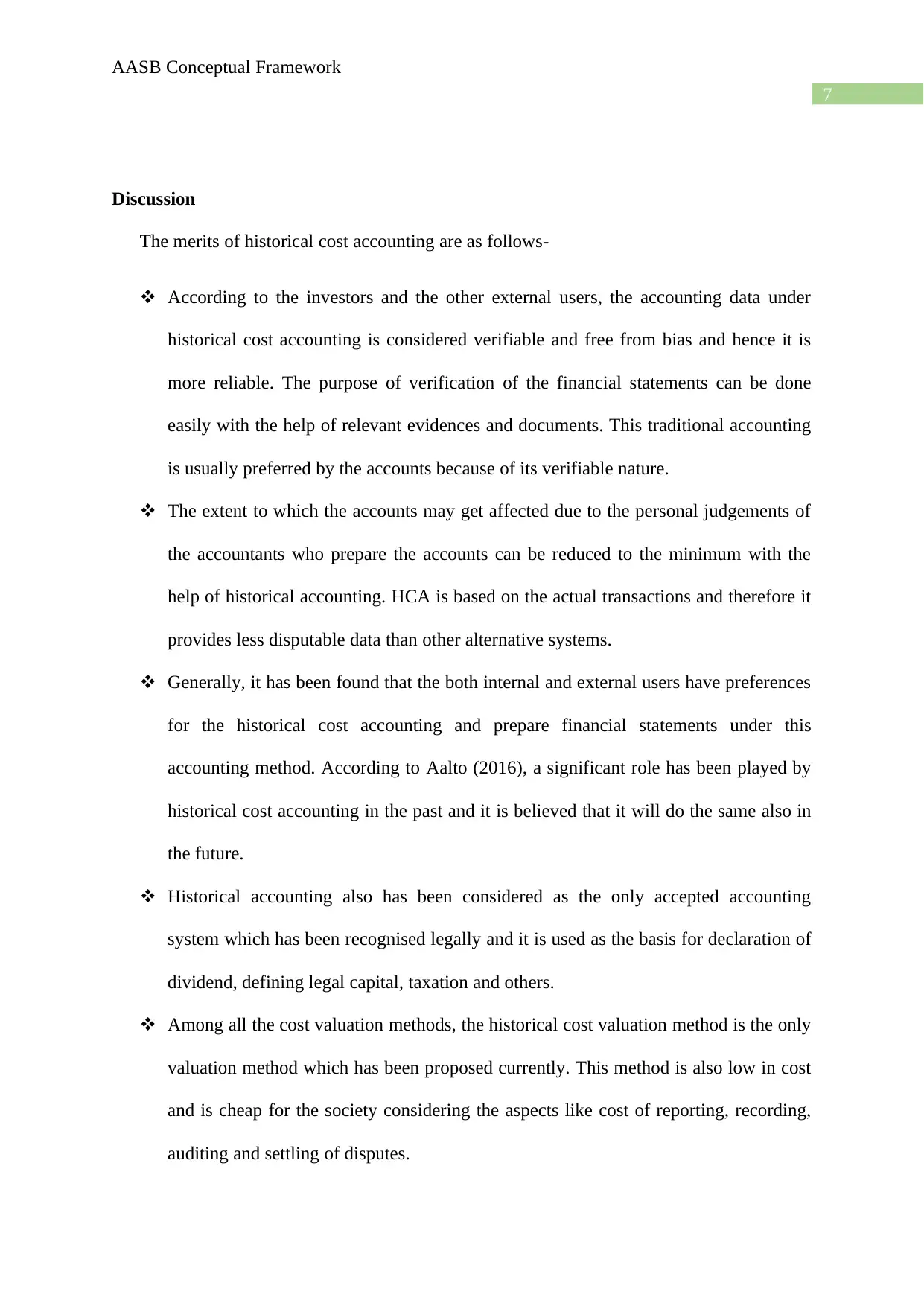
7
AASB Conceptual Framework
Discussion
The merits of historical cost accounting are as follows-
According to the investors and the other external users, the accounting data under
historical cost accounting is considered verifiable and free from bias and hence it is
more reliable. The purpose of verification of the financial statements can be done
easily with the help of relevant evidences and documents. This traditional accounting
is usually preferred by the accounts because of its verifiable nature.
The extent to which the accounts may get affected due to the personal judgements of
the accountants who prepare the accounts can be reduced to the minimum with the
help of historical accounting. HCA is based on the actual transactions and therefore it
provides less disputable data than other alternative systems.
Generally, it has been found that the both internal and external users have preferences
for the historical cost accounting and prepare financial statements under this
accounting method. According to Aalto (2016), a significant role has been played by
historical cost accounting in the past and it is believed that it will do the same also in
the future.
Historical accounting also has been considered as the only accepted accounting
system which has been recognised legally and it is used as the basis for declaration of
dividend, defining legal capital, taxation and others.
Among all the cost valuation methods, the historical cost valuation method is the only
valuation method which has been proposed currently. This method is also low in cost
and is cheap for the society considering the aspects like cost of reporting, recording,
auditing and settling of disputes.
AASB Conceptual Framework
Discussion
The merits of historical cost accounting are as follows-
According to the investors and the other external users, the accounting data under
historical cost accounting is considered verifiable and free from bias and hence it is
more reliable. The purpose of verification of the financial statements can be done
easily with the help of relevant evidences and documents. This traditional accounting
is usually preferred by the accounts because of its verifiable nature.
The extent to which the accounts may get affected due to the personal judgements of
the accountants who prepare the accounts can be reduced to the minimum with the
help of historical accounting. HCA is based on the actual transactions and therefore it
provides less disputable data than other alternative systems.
Generally, it has been found that the both internal and external users have preferences
for the historical cost accounting and prepare financial statements under this
accounting method. According to Aalto (2016), a significant role has been played by
historical cost accounting in the past and it is believed that it will do the same also in
the future.
Historical accounting also has been considered as the only accepted accounting
system which has been recognised legally and it is used as the basis for declaration of
dividend, defining legal capital, taxation and others.
Among all the cost valuation methods, the historical cost valuation method is the only
valuation method which has been proposed currently. This method is also low in cost
and is cheap for the society considering the aspects like cost of reporting, recording,
auditing and settling of disputes.
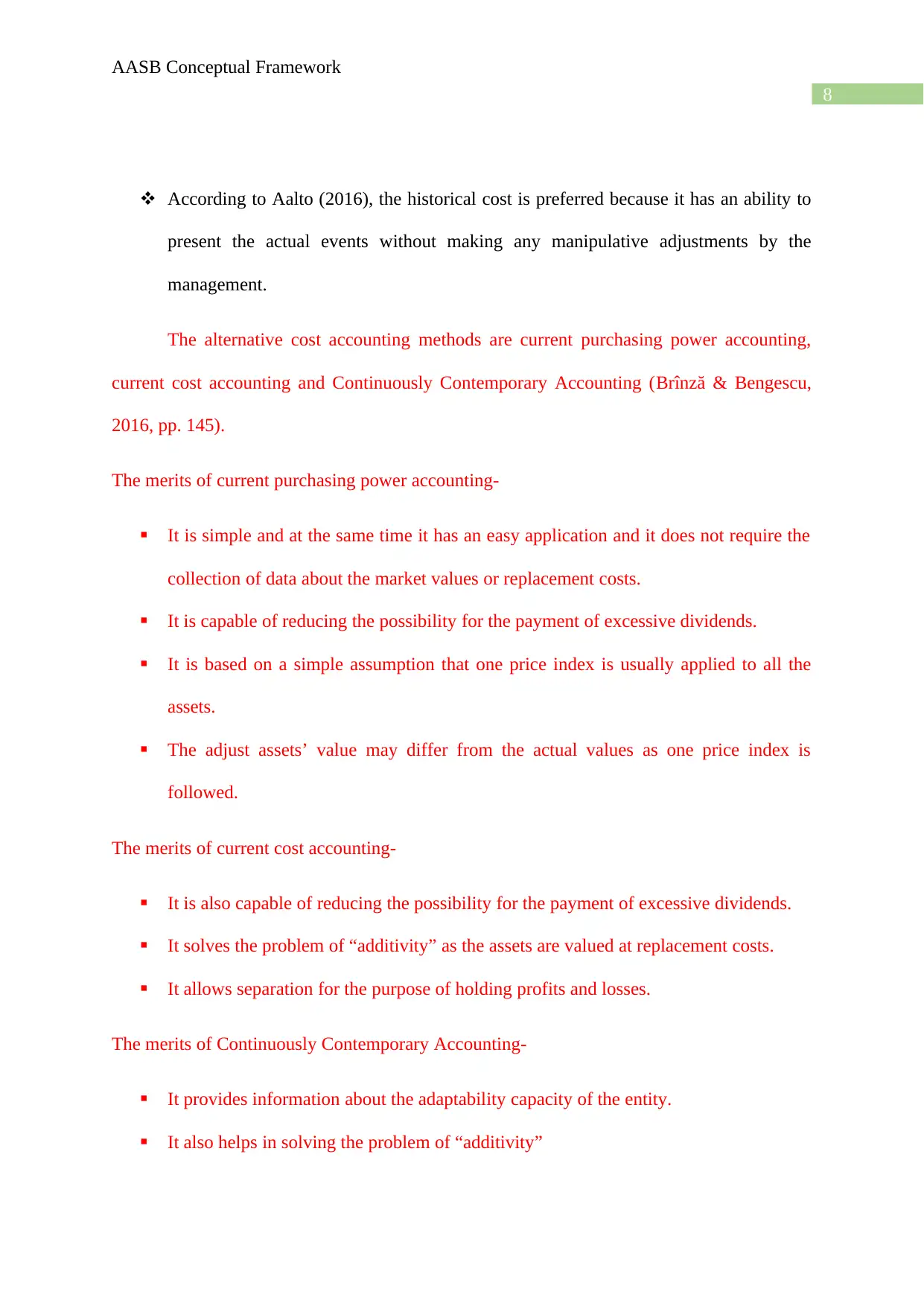
8
AASB Conceptual Framework
According to Aalto (2016), the historical cost is preferred because it has an ability to
present the actual events without making any manipulative adjustments by the
management.
The alternative cost accounting methods are current purchasing power accounting,
current cost accounting and Continuously Contemporary Accounting (Brînză & Bengescu,
2016, pp. 145).
The merits of current purchasing power accounting-
It is simple and at the same time it has an easy application and it does not require the
collection of data about the market values or replacement costs.
It is capable of reducing the possibility for the payment of excessive dividends.
It is based on a simple assumption that one price index is usually applied to all the
assets.
The adjust assets’ value may differ from the actual values as one price index is
followed.
The merits of current cost accounting-
It is also capable of reducing the possibility for the payment of excessive dividends.
It solves the problem of “additivity” as the assets are valued at replacement costs.
It allows separation for the purpose of holding profits and losses.
The merits of Continuously Contemporary Accounting-
It provides information about the adaptability capacity of the entity.
It also helps in solving the problem of “additivity”
AASB Conceptual Framework
According to Aalto (2016), the historical cost is preferred because it has an ability to
present the actual events without making any manipulative adjustments by the
management.
The alternative cost accounting methods are current purchasing power accounting,
current cost accounting and Continuously Contemporary Accounting (Brînză & Bengescu,
2016, pp. 145).
The merits of current purchasing power accounting-
It is simple and at the same time it has an easy application and it does not require the
collection of data about the market values or replacement costs.
It is capable of reducing the possibility for the payment of excessive dividends.
It is based on a simple assumption that one price index is usually applied to all the
assets.
The adjust assets’ value may differ from the actual values as one price index is
followed.
The merits of current cost accounting-
It is also capable of reducing the possibility for the payment of excessive dividends.
It solves the problem of “additivity” as the assets are valued at replacement costs.
It allows separation for the purpose of holding profits and losses.
The merits of Continuously Contemporary Accounting-
It provides information about the adaptability capacity of the entity.
It also helps in solving the problem of “additivity”
⊘ This is a preview!⊘
Do you want full access?
Subscribe today to unlock all pages.

Trusted by 1+ million students worldwide
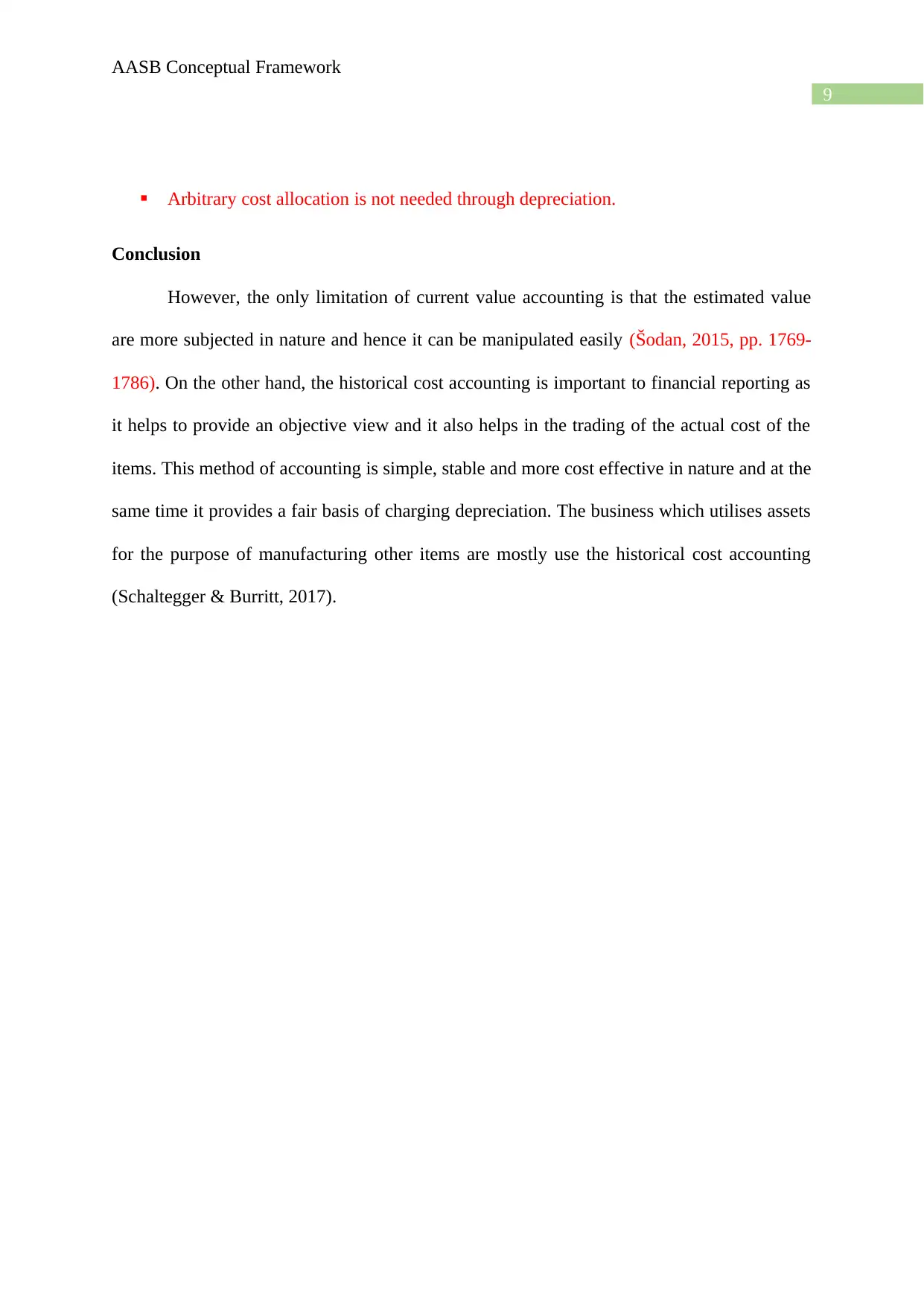
9
AASB Conceptual Framework
Arbitrary cost allocation is not needed through depreciation.
Conclusion
However, the only limitation of current value accounting is that the estimated value
are more subjected in nature and hence it can be manipulated easily (Šodan, 2015, pp. 1769-
1786). On the other hand, the historical cost accounting is important to financial reporting as
it helps to provide an objective view and it also helps in the trading of the actual cost of the
items. This method of accounting is simple, stable and more cost effective in nature and at the
same time it provides a fair basis of charging depreciation. The business which utilises assets
for the purpose of manufacturing other items are mostly use the historical cost accounting
(Schaltegger & Burritt, 2017).
AASB Conceptual Framework
Arbitrary cost allocation is not needed through depreciation.
Conclusion
However, the only limitation of current value accounting is that the estimated value
are more subjected in nature and hence it can be manipulated easily (Šodan, 2015, pp. 1769-
1786). On the other hand, the historical cost accounting is important to financial reporting as
it helps to provide an objective view and it also helps in the trading of the actual cost of the
items. This method of accounting is simple, stable and more cost effective in nature and at the
same time it provides a fair basis of charging depreciation. The business which utilises assets
for the purpose of manufacturing other items are mostly use the historical cost accounting
(Schaltegger & Burritt, 2017).
Paraphrase This Document
Need a fresh take? Get an instant paraphrase of this document with our AI Paraphraser
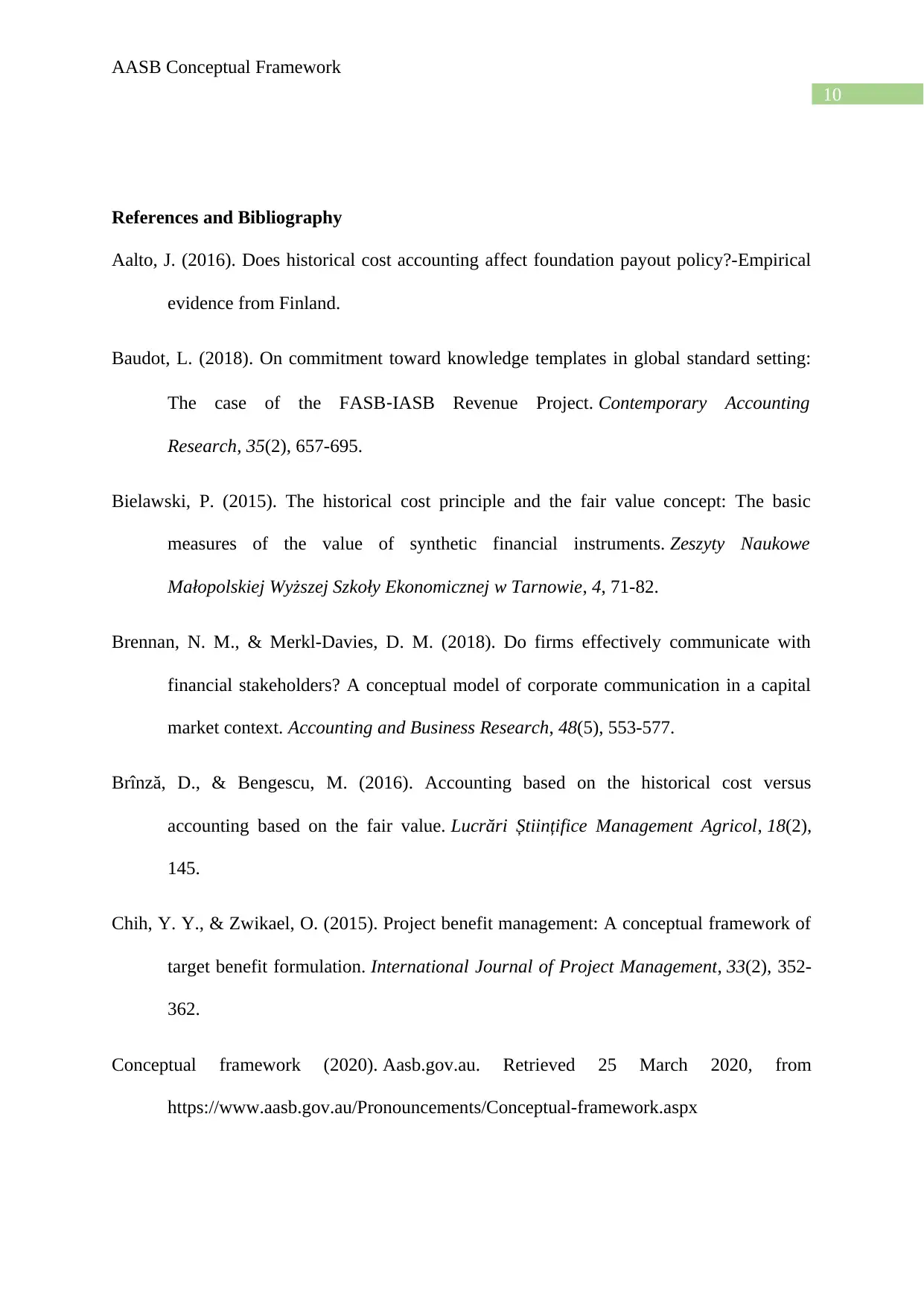
10
AASB Conceptual Framework
References and Bibliography
Aalto, J. (2016). Does historical cost accounting affect foundation payout policy?-Empirical
evidence from Finland.
Baudot, L. (2018). On commitment toward knowledge templates in global standard setting:
The case of the FASB‐IASB Revenue Project. Contemporary Accounting
Research, 35(2), 657-695.
Bielawski, P. (2015). The historical cost principle and the fair value concept: The basic
measures of the value of synthetic financial instruments. Zeszyty Naukowe
Małopolskiej Wyższej Szkoły Ekonomicznej w Tarnowie, 4, 71-82.
Brennan, N. M., & Merkl-Davies, D. M. (2018). Do firms effectively communicate with
financial stakeholders? A conceptual model of corporate communication in a capital
market context. Accounting and Business Research, 48(5), 553-577.
Brînză, D., & Bengescu, M. (2016). Accounting based on the historical cost versus
accounting based on the fair value. Lucrări Științifice Management Agricol, 18(2),
145.
Chih, Y. Y., & Zwikael, O. (2015). Project benefit management: A conceptual framework of
target benefit formulation. International Journal of Project Management, 33(2), 352-
362.
Conceptual framework (2020). Aasb.gov.au. Retrieved 25 March 2020, from
https://www.aasb.gov.au/Pronouncements/Conceptual-framework.aspx
AASB Conceptual Framework
References and Bibliography
Aalto, J. (2016). Does historical cost accounting affect foundation payout policy?-Empirical
evidence from Finland.
Baudot, L. (2018). On commitment toward knowledge templates in global standard setting:
The case of the FASB‐IASB Revenue Project. Contemporary Accounting
Research, 35(2), 657-695.
Bielawski, P. (2015). The historical cost principle and the fair value concept: The basic
measures of the value of synthetic financial instruments. Zeszyty Naukowe
Małopolskiej Wyższej Szkoły Ekonomicznej w Tarnowie, 4, 71-82.
Brennan, N. M., & Merkl-Davies, D. M. (2018). Do firms effectively communicate with
financial stakeholders? A conceptual model of corporate communication in a capital
market context. Accounting and Business Research, 48(5), 553-577.
Brînză, D., & Bengescu, M. (2016). Accounting based on the historical cost versus
accounting based on the fair value. Lucrări Științifice Management Agricol, 18(2),
145.
Chih, Y. Y., & Zwikael, O. (2015). Project benefit management: A conceptual framework of
target benefit formulation. International Journal of Project Management, 33(2), 352-
362.
Conceptual framework (2020). Aasb.gov.au. Retrieved 25 March 2020, from
https://www.aasb.gov.au/Pronouncements/Conceptual-framework.aspx
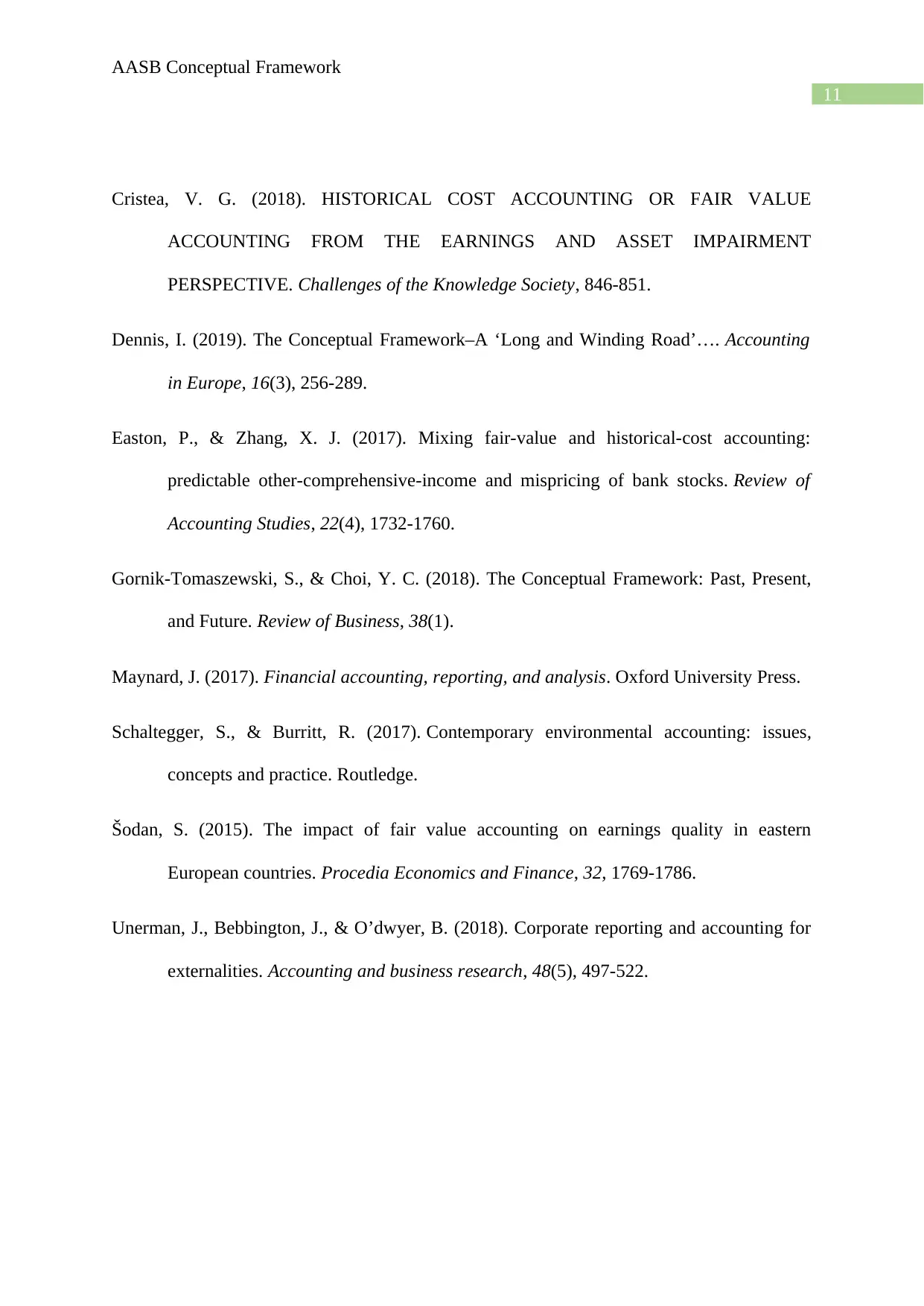
11
AASB Conceptual Framework
Cristea, V. G. (2018). HISTORICAL COST ACCOUNTING OR FAIR VALUE
ACCOUNTING FROM THE EARNINGS AND ASSET IMPAIRMENT
PERSPECTIVE. Challenges of the Knowledge Society, 846-851.
Dennis, I. (2019). The Conceptual Framework–A ‘Long and Winding Road’…. Accounting
in Europe, 16(3), 256-289.
Easton, P., & Zhang, X. J. (2017). Mixing fair-value and historical-cost accounting:
predictable other-comprehensive-income and mispricing of bank stocks. Review of
Accounting Studies, 22(4), 1732-1760.
Gornik-Tomaszewski, S., & Choi, Y. C. (2018). The Conceptual Framework: Past, Present,
and Future. Review of Business, 38(1).
Maynard, J. (2017). Financial accounting, reporting, and analysis. Oxford University Press.
Schaltegger, S., & Burritt, R. (2017). Contemporary environmental accounting: issues,
concepts and practice. Routledge.
Šodan, S. (2015). The impact of fair value accounting on earnings quality in eastern
European countries. Procedia Economics and Finance, 32, 1769-1786.
Unerman, J., Bebbington, J., & O’dwyer, B. (2018). Corporate reporting and accounting for
externalities. Accounting and business research, 48(5), 497-522.
AASB Conceptual Framework
Cristea, V. G. (2018). HISTORICAL COST ACCOUNTING OR FAIR VALUE
ACCOUNTING FROM THE EARNINGS AND ASSET IMPAIRMENT
PERSPECTIVE. Challenges of the Knowledge Society, 846-851.
Dennis, I. (2019). The Conceptual Framework–A ‘Long and Winding Road’…. Accounting
in Europe, 16(3), 256-289.
Easton, P., & Zhang, X. J. (2017). Mixing fair-value and historical-cost accounting:
predictable other-comprehensive-income and mispricing of bank stocks. Review of
Accounting Studies, 22(4), 1732-1760.
Gornik-Tomaszewski, S., & Choi, Y. C. (2018). The Conceptual Framework: Past, Present,
and Future. Review of Business, 38(1).
Maynard, J. (2017). Financial accounting, reporting, and analysis. Oxford University Press.
Schaltegger, S., & Burritt, R. (2017). Contemporary environmental accounting: issues,
concepts and practice. Routledge.
Šodan, S. (2015). The impact of fair value accounting on earnings quality in eastern
European countries. Procedia Economics and Finance, 32, 1769-1786.
Unerman, J., Bebbington, J., & O’dwyer, B. (2018). Corporate reporting and accounting for
externalities. Accounting and business research, 48(5), 497-522.
⊘ This is a preview!⊘
Do you want full access?
Subscribe today to unlock all pages.

Trusted by 1+ million students worldwide
1 out of 12
Related Documents
Your All-in-One AI-Powered Toolkit for Academic Success.
+13062052269
info@desklib.com
Available 24*7 on WhatsApp / Email
![[object Object]](/_next/static/media/star-bottom.7253800d.svg)
Unlock your academic potential
Copyright © 2020–2025 A2Z Services. All Rights Reserved. Developed and managed by ZUCOL.




